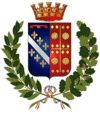Canosa di Puglia
- Not to be confused with Canossa in Emilia-Romagna, or Canosa Sannita in Abruzzo.
| Canosa di Puglia | |||
|---|---|---|---|
| Comune | |||
| Comune di Canosa di Puglia | |||
 | |||
| |||
| Nickname(s): La Piccola Roma | |||
| Motto: "Città d'Arte e Cultura" or "The City of Princes, Emperors and Bishops" | |||
 Canosa di Puglia | |||
| Coordinates: 41°13′N 16°4′E / 41.217°N 16.067°E | |||
| Country | Italy | ||
| Region |
| ||
| Province | Barletta-Andria-Trani (BAT) | ||
| Founded | 6000-3000 BC | ||
| Frazioni | Loconia | ||
| Government | |||
| • Mayor | Ernesto La Salvia (PD) | ||
| Area | |||
| • Total | 149 km2 (58 sq mi) | ||
| Elevation | 105 m (344 ft) | ||
| Highest elevation | 249 m (817 ft) | ||
| Lowest elevation | 31 m (102 ft) | ||
| Population (31 March 2008) | |||
| • Total | 31,271 | ||
| • Density | 210/km2 (540/sq mi) | ||
| Demonym | Canosini | ||
| Time zone | CET (UTC+1) | ||
| • Summer (DST) | CEST (UTC+2) | ||
| Postal code | 70053 | ||
| Dialing code | 02 | ||
| Patron saint | Sabinus of Canosa | ||
| Saint day | August 1 | ||
| Website | Official website | ||
Canosa di Puglia (in Apulian dialect Canaus; in Latin Canusium; in Greek Canusion) is a town and comune in Apulia in southern Italy, between Bari and Foggia, located in the province of Barletta-Andria-Trani, not far from the position on the Ofanto River where the Romans found refuge after the defeat of the Battle of Cannae. It is the burial place of Bohemund I of Antioch.
It is located on the northwestern edge of the plateau of the Murgia which dominates the Ofanto valley and the extensive plains of Tavoliere delle Puglie, ranging from Mount Vulture at the Gargano, to the Adriatic coast.
Canosa is considered the principal archaeological center of Puglia, and is one of the oldest continually inhabited cities in Italy.[1] A number of important vases and other archaeological finds are located in local museums and private collections.
Physical geography
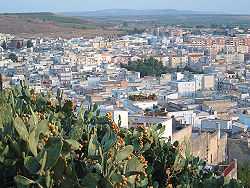
Territory
Canosa sits on the right bank of the Ofanto river and is nearly twenty kilometers from the Adriatic Sea. The town sits upon the Murgia plateau (between 105 and 140 m asl). The city is built on a mostly sandy or clay surface that covers a limestone layer ("calcareniti of Gravina") which in turn constitutes the typical white-yellowish tuff and is easily collapsible. This morphological feature allowed the underground construction of artificial grottoes (used in the 19th century as cellars), and the creation of a Hypogean. The tuff derived from the excavations has gone towards the construction of buildings on the surface. There are risks of subsidence due to the presence of caves and underground channels typical of karst environments. The buildings of the town of Canosa are considered high risk for collapse.[2] In recent years there have been many building failures and disruptions of roads. The area extends south to the slopes of the Murgia, and is mostly flat. The basins of Rendina and Locone contribute to the large area (150 km ²).
Climate

Canosa has a typical temperate climate, mild spring and autumn, and cold winters and mild summers. The monthly average temperature is strongly influenced by the Murgiano Range from 7.7 °C (46 °F) in January, to 24.9 °C (77 °F) in August. The average annual rainfall is 547 mm (21.5 in) of rainfall, distributed mainly in the period from September to April.[3] Climate classification of Canosa is Climate zone C.
Etymology
There are many hypotheses advanced to explain the etymology of the name Canosa. The first hypothesis sees the origin in the worship of Aphrodite in Daun. According to this hypothesis, supported by the Latin commentator Servius, Canusium derives from canis (dog), an animal associated with the Greek god Aphrodite en kepois.[4] Another theory provides a derivation from the Greek word χάνεον (basket / wicker basket) for the presence of large wicker growing naturally along the banks of the Ofanto river. A third possibility provides for deriving from the Hebrew Chanuth (Tavern), became the word Chanush, both would be supplemented by the called or suffix -ion iapigio (then -ium in Latin). Further research sees a direct correlation between the Latin nomen Canusium and Etruscan canzna. This hypothesis is based on the Etruscan presence in Lazio before the Roman conquest and the lively trade along the Etruscan Ofanto valley. This is supported by the conspicuous presence of products of the Etruscan metal techniques and Amber (kept at the British Museum in London) which have the stylistic motifs common to the Etruscan.[5]
History
Ancient

According to tradition, Canosa, then called Canusium, was founded by the Homeric hero Diomedes. Historically, it was one of the main center of the Dauni, in an area where human presence dates back from the 7th millennium BC. The first indigenous settlements (consisting of Dauni, northern branch of the Iapyges people) established on a strip of land called the Diomedea fields, dates back to the Neolithic (6000-3000 BC). The archaic settlement of Toppicelli on the Ofantina plain, has the presence of buildings and tombs of rich aristocratic outfits belonging to the class defined as "Dauni principles."[6] Over the centuries, Canosa became an important commercial center for craftsman (especially ceramics and pottery). With the development of Magna Grecia, the center is influenced by Hellenistic culture (morphologically and urban Canosa is territory for the formation of a Greek polis). In 318 BC Canosa city becomes an ally of Rome, welcoming the Romans after their defeat by Hannibal in 216 BC at Cannae, a small village near the Ofanto. In 88 BC it becomes a municipium and undergoes changes typical of the Romans such as the passage of the Via Traiana (109 AD) the construction of the aqueduct of Herodes Atticus (141 AD), amphitheater, and mausoleums. A little later the emperor Antoninus Pius elevates the center to capital of the Provincia Apuliae et Calabriae.[7]
Medieval
Towards the end of the 3rd century it became the capital of Apulia and Calabria II Royal, becoming the fourth seat of one of the largest dioceses in Puglia, and reached its greatest significance from the Bishopric of Saint Sabino (from 514 to 566). The presence of an Episcopal district left the artistic values of places of worship and civil architecture earning the nickname "city of bishops".[8] Under the Lombards, it was the seat of the Gastaldate, and in the following centuries suffered several Saracen attacks. Under the Normans (11th-12th centuries) Canosa recovered some importance, in particular due to prince Bohemund I of Antioch. However, after the end of the Hohenstaufen domination in Italy, it went into a decline.[9]
Feudal era
As the imperial age went into decline, continued up to the 18th century, it is accentuated by the many earthquakes (1361, 1456, 1627, 1659), experiences being sacked (in particular, the Tarantini in 1451 and the French troops of Napoleon Bonaparte in 1803) and loss of the bishopric. Canosa became a fief, managed by Casati and later the Orsini of Balzo, the Grimaldi of Monaco, the de Gemmis barons of Castelfoce, the Affaitati of Barletta, and the Capece Minutolo of Naples.[10]
Contemporary
After the wars of independence and the disastrous earthquake in 1851, Canosa remained predominantly bourgeois country demonstrated by the construction of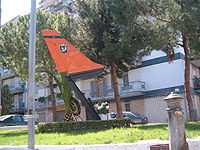
On 6 November 1943, shortly after the 8 September armistice, the country was bombed during World War II. Some buildings damaged include the church of San Francesco and San Biagio and part of the Town Hall, and 57 people lost their lives. In April 2001 the City of Canosa was awarded the bronze medal for Civil Valor in remembrance of the tragedy. On 17 September 1962, by decree of the President, Canosa was awarded the title of City for its historical traditions and the merits acquired by the community. In 1980 Canosa was again damaged by earthquake. As many times in the past, the town found itself in a state of emergency, with old buildings and some churches declared unusable. Ora sede della locale Fondazione Archeologica (F.A.C.) [2]
Currently Canosa is a center based mainly on agriculture, with a service sector (archaeological tourism) and industry and handicrafts (textiles, food processing and manufacturing).
Main sights

Religious architecture
Cathedral of San Sabino
Cathedral of San Sabino was built by the Lombards (7th-8th century), through Duke Arechi II, after the abandonment of early Christian sites in San Leucio and St. Peter. Originally dedicated to Saints John and Paul, was named after St. Sabinus of Canosa on 7 September 1101, by Pope Paschal II, some four hundred years after the transfer of the saint’s remains in the crypt. It was recognized as a cathedral in 1916 by Pope Benedict XV.[12]

After the earthquake of 1851, the cathedral was damaged and the impressive restoration work continued an expansion of the Latin cross, which rebuilt the facade in local tuff with three portals, each corresponding to the aisles, in turn supplemented by eight. The chapels contain in order: a baptismal font, a fresco, an altar dedicated to Our Lady of the Fountain (protectress of Canosa) whose icon came after the First Crusade, in the adjacent Mausoleum of Bohemond, the wooden statue and a painting of Alphonsus Maria de Liguori, and the tomb of Blessed Father Antonio Maria Losito (1838–1917). On the left aisle, there is the tomb of the Bishop of Lecce Archbishop Francesco Minerva (1904–2004) following three chapels: one containing the relics, chalices, crucifixes, and a silver bust of the saint enclosed by an iron grating, and the other dedicated to St. Anthony (but with canvas representing St. Francis of Assisi), the third devoted to St. Anne. On the left arm of a Latin cross are two other chapels that of the St. Sacramento containing the statue of the Sacred Heart and the other of St. Joseph.[14] The presbytery has a high altar with ciborium, set on a marble base with three steps, surmounted by a canopy supported by four red marble columns with Corinthian capitals, octagonal pyramid in two sections held up a total of 48 columns of the same marble, very similar to that in the Basilica of San Nicola di Bari.[15]
Mausoleum of Bohemond

Accessible from the right transept of the cathedral is the Mausoleum of Bohemond of Hauteville.( you will have to ask a Church official to unlock the door which gives access ). Erected after 1111, the death year of the Prince, the little building has an upper part characterized by a polygonal drum surmounted by a hemispherical dome. Opposite the door to the Mausoleum is a stone carved heraldic device, a Lion Rampant, the style of which appears contemporary with Bohemond, and could therefore represent his personal Coat of Arms. An asymmetrical bronze double door (now preserved in the side chapel in the adjoining Basilica of Our Lady of the Fountain) was probably created by Roger Melfi (11th century). Inside, in addition to the columns, one going deep, there is on the marble floor with the word "BOAMVNDVS".[16]
Churches minors and rector
- Church of St. Anthony of Padua
- Church of St. Catherine
- Church of Saints Francis and Blaise
- Church of Saint Lucia and Teodoro, also called the Blessed Purgatory
- Church of Our Lady of the Assumption
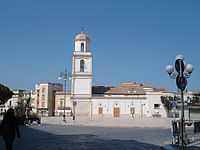 Piazza Vittorio Veneto Church
Piazza Vittorio Veneto Church - Church of Our Lady of Constantinople
- Church of Maria Immacolata
- Church of Maria del Caramel and Carmine
- Church of Maria del Rosario O Rosal
- Church of Passion of Jesus Christ (Rector)
- Church of Jesus the Liberator
- Church of Jesus, Joseph and Mary -
- Church of St. John the Baptist
- Church of St. Therese of the Child Jesus -
Civil architecture
Historical buildings
The center of the city is littered with 18th- and 19th-century buildings of great artistic and aesthetic value.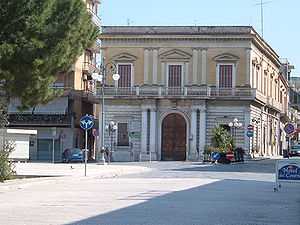
- Casieri palace
- Iliceto palace, housing a puppet museum (19th-20th centuries).
- Palazzo Scocchera Santa
- Palazzo Barbarossa
- Rossi Palace
- Palazzo Sinesi, containing 400 findings dating back to the 4th-3rd centuries BC.
- Palace De Muro Fiocco
- Palazzo Fracchiolla-Minerva
- City Palace
- Caporale palace
- Palazzo Visconti
- Palace Forino on via De Gasperi
- Mazzini School via Piave
Teatro D'Ambra
The city 's historic theater is the Teatro D'Ambra, now owned by the city and renamed Teatro Comunale. Its construction was commissioned by Raffaele Lembo, a wealthy local grain merchant, and dates back to 1923. The draft prepared by engineer and architect Arturo Boccasini of Barletta, had designed the Teatro Di Lillo of Barletta and had collaborated on the project of Teatro Margherita di Bari. The theater was opened in late 1926 when, with scarce economic resources, they completed part of the structure including without ornaments and decorations. Purchased by the City of Canosa and delivered to the city on February 5 in 2005, the historic theater will be completely renovated and restored to house performances again.[17] In May 2006 the renovation work were frozen after of an exceptional archaeological discovery, which was found under the gallery of the theater. This is a complicated intersection of Imperial age with some structures being from the Archaic Age (8th-7th centuries BC).
Other
Villa Comunale
The Villa Comunale, the center of Canosa, has its origins in the 19th century. Mayor Vincent Sinesi who in 1888 arranged the building adjacent to the Cathedral and the Mausoleum of Bohemond to be donated to the municipality by a few Canosa families. Beyond the Mausoleum of Bohemond, there is a monument dedicated to Scipio Africanus, and an altar commemorating the fallen of all wars. The lapidarium is composed of a remarkable archaeological heritage with Dauna and Roman inscriptions, funerary reliefs, capitals and columns, lintels, and the well of the imperial villas.
Archaeological sites
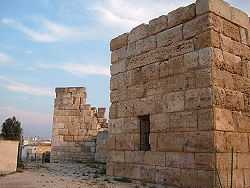
The Castle
Called by the natives Castle, it was actually the acropolis of ancient Canosa (Castrum canus). The three great towers are the ruins of the eponymous estate located atop the hill overlooking the valley Ofantina. Originally a place of worship and pre-Roman fort, built of tufa blocks was rebuilt as a bastion of the same materials by the Grimaldi. Last owners, from 1856, were the Prince of Canosa Capece Minutolo of Naples, and remained until 1948.[18] The wear of the blocks that compose it and the color denotes the passage of these various civilizations that have developed the structure in different epochs. The castle has also reported damage after the devastating bombing of the Second World War.[19] Along the steep hill of the Acropolis, there is the old part of the country, with its narrow streets and staircases. At the southern base lie the remains of a Roman amphitheater.
Hypogeum and catacombs
Canosa has ancient Hypogeum (many probably still hidden). These were used first by Dauni as pagan catacombs, and, within them, celebrated funerary cults, demonstrating an advanced civilization in the vast era from 6000 BC to 2nd century AD). The burials in the tombs continued to Roman times. The tombs contained, in addition to the deceased (often found in the fetal position), personal items found in urns or deposited in niches.[20] Over the years, however, many of these artifacts (including precious jewelry in gold and bronze, pottery, red figures and askos) have been lost (or in private hands) due to grave robbers. Often these sites have frescoes with an allegorical passage of the deceased to take in the afterlife (for dedutio inferos). The most important are those of the Cerberus, Lagrasta, Boccaforno and the Hoplite. Other exhibits recovered at the local Museum.

Not far from the town lies in the depths of clay soil, the necropolis of Santa Sofia. Used around the 4th century AD, for early Christians, it extended over other tombs dating back to the time of the persecution against the Christians. It was discovered around 1960 and is undergoing restoration.[21] Other hypogeum and catacombs include:
- Ori Tomb (4th century BC)
- Ipogei Monterisi-Rossignoli (4th century BC)
- Varrese Tomb (4th century BC)
- Hypogeum Cerberus (4th century BC)
- Ipogeo Scocchera A (4th century BC)
- Ipogeo Scocchera B (called Ipogeo Boccaforno, 4th century BC)
- Ipogei Casieri (4th century BC)
- Hypogeum Vessel Dario (4th century BC)
- Ipogei Lagrasta (2nd century BC)
- Ipogeo dell'Oplita (2nd century BC)
- Ipogeo Matarrese
- Ipogeo Reimers
- Tomb of Largo Constantinople (3rd century BC)
- Necropolis of Santa Sofia (2nd-4th century AD)
Temples and archaic churches
Basilica di San Leucio

The Basilica of San Leucio is one of the greatest examples of early Christian architecture in Puglia. A pagan temple until the 2nd century AD, probably dedicated to Minerva, was transformed into a Christian Basilica between the 4th and 5th centuries AD The structure is the result of merging the cultures of Magna Graecia and Italica consisting of a cell dedicated to worship located between two large rooms, with polychrome mosaics, tufa plastered figured capitals and painted columns in Doric – Ionic. The early Christian Basilica of San Leucio was built on a Hellenistic temple. Its construction reused the already existing walls, columns and capitals. The floor plan is called a double envelope consists of an outer wall of square shape (50 m square) with exedra on each side within which there is a second concentric squares with colonnade exedras. The architecture of the basilica is of oriental inspiration, with preference for large color spaces. In the 9th century a chapel was built adjoining the apse for burial rites.[22]
Basilica di San Pietro
The Basilica di San Pietro was the first cathedral of the Christian era, then transformed into a tomb of Saint Sabino (556), patron of Canosa. The complex is with three naves, apse and narthex of St. Peter's, preceded by a large atrium portico and bordered by a residential building and several other structures used in cemetery functions: a mausoleum, the Sepulchre of Bishop Sabino, a large brick kiln devoted to cooking and a domus, used probably as a bishop's residence. Also present are mosaics and Doric-Ionic capitals. Since 2001 the entire area is ongoing systematic excavation by the University of Foggia and the University of Bari.[23]
Baptistry of San Giovanni
The main body of the twelve-sided shape, contained a heptagonal baptismal font. The compositions were mainly in marble and tuff. The columns that support the barrel vault was damaged over time, as they have lost the gold mosaics that once covered it. Corresponding to the cardinal points, left four small dodecagon aisles to form a structure of a Greek cross. In the 1800s, it was used as a mill. Nevertheless, such use did not affect the status of the building. Since 2001 it is the subject of research by the University of Foggia. Recently, under the Baptistry, have yielded two distinct levels of an early Christian church.[24]
Temple of Jupiter Taurus
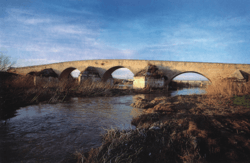
The Roman temple of Jupiter Taurus peripteral with six columns on the short sides and ten on the long sides, and a brick staircase, took its name from a statue of Zeus found at the excavation in 1978.[25]
Other sites
Among other monuments are the Ofanto Roman Bridge (1st century AD), which allowed the passage of the Via Traiana from one side of the river and has been used for road traffic until the 1970s. It was reconstructed in the Middle Ages and restored again in 1759. The base consists of four pillars shaped like a spearhead and five mixed arches. Notable are the Tower and Mausoleums, Casieri Bagnoli and Barbarossa, and the Arch of Gaius Terentius Varro, opus latericium and the opus reticulatum monuments dedicated to the passage of the Roman consul in the Battle of Cannae. The first three sites preserve the remains of some of the fallen in the battle.[26] Finally, the Roman Baths (Ferrara and Lomuscio) located in the city center came to light in the 1950s. They have enriched apse mosaics.

Society
Languages and dialects
The dialect is a primary Italoromanzo dialect arising directly from the Vulgar Latin spoken in ancient Canusium. Linguistically, part of the southern dialects spoken in North Central Puglia. The vocabulary is almost entirely of Latin origin influences of ancient Greek. Even Norman domination has left some words, without upsetting the existing lexical and grammatical system. The Canosa dialect was approached phonetically in French, but some recent studies have found the same Tubatulaba phonological system, a language of North America of the Shoshoni language group, and Uto-Aztecan languages.[27]
Culture
Education
Canosa is home to four secondary schools:
- State Professional Institute for Agriculture and the Environment "May 1".
- Nicola Garrone State Professional Institute for Trade.
- Luigi Einaudi Istituto Tecnico Commerciale Statale
- Enrico Fermi Liceo Scientifico Statale
Museums
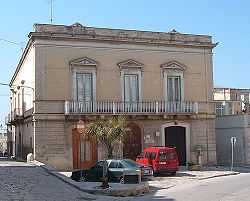
Museo Civico Archeologico
The Archaeological Museum was established in 1934 and placed in the 18th-century Casieri palace. It houses about 2,000 archaeological finds from excavations in tombs at Canosa and the 5th-3rd centuries BC. There are inscriptions, sculptures, reliefs, marbles, coins, jewelry, ceramics and pottery dating back to a broad span of about 1500 years representing the ancient Dauno, Roman, early Christian and medieval Byzantine.[28] In the past, the museum has been deprived of some pieces of inestimable value, such as gold from the Tomb of the Ori. These jewels are now held at the National Archaeological Museum of Taranto, and scattered in major Italian and European museums (including the Louvre Museum in Paris). The museum collection includes:
- Pieces of red-figure pottery and amphorae.
- Cruet, pitchers, bowls, jars, amphoras, urns, small vases in the 3rd century BC
- Jewish, Roman and Christian lamps. There are also a clay statue of a woman in prayer and some lead of the aqueduct of Herodes Atticus
- Coinage of Canusium.
- Askos and lekanoi polychrome Iapyges inscriptions,
- Fragments of medieval pottery and Neolithic flints.
Palazzo Sinesi - Archaeological Foundation Canosina

Palazzo Sines (19th century), has since 1994 been an exhibition space for thematic exhibitions. It is the seat of the Archaeological Foundation Canosina and home to the Superintendent of Archaeological Heritage of Puglia.[29]
Palazzo Iliceto
Palazzo Iliceto is an imposing 18th-century building intended as an exhibition space for special exhibits. Until 2005 it was the home of the Museo delle Marionette Canosa, and since 2005 houses the archaeological exhibition God with lightning. It was also used for some theater in the summer of 2003, and outdoor film screenings in the summers of 2004 and 2005. Exhibitions include:
- God with lightning (from 18 May 2005): This is an archaeological exhibition that has images sacred to Canusium, sponsored by the Foundation Archaeological Canosina.[30]
- The Museum of Puppets (the valuable and interesting collection of Aquila-Taccardi: an assortment of 52 large characters in beech, walnut and pine, antique silk robes, armor, copper and nickel silver represented noble Spanish Christians, princesses and Saracens, popes, dukes and cardinals.
- The days of the sacred (2003) show the traditions of Holy Week and in Canosa di Puglia.[31]
Museum of Country Life
The Museum of Country Life is housed in an old bakery in the service area of the castle and is sporadically open during the summer, the patron festivals, and at events organized in the castle. The museum, through an extensive development of original objects, traces the daily rural life in the last century, browsing habits and customs of a civilization now vanished.[32] The museum is divided into three macro-areas:
- Domestic life: pots, kettles, wooden spoons, faggots to feed the flame and other tools for preparation of food farmers. Also furniture, a stroller, representations of deities placed on the facades of houses.
- Agriculture: pruning scissors, blankets, bags, straining vats, crusher, press and barrels of various sizes, plows, hoes, harrows, and agrarian civilization objects linked to production and consumption of extra virgin olive oil, wine and wheat.
- The craft: the tools of the blacksmith, the tinsmith, shoemaker, plus all the necessary trades related to the processing of clay, hides, the production of cheeses and dairy products.
Food and Wine
The Canosina gastronomic tradition is strongly linked to rural tradition and Mediterranean architecture. One of the most characteristic is the burned flour of wheat (in the Apulian dialect gren IARS): A dark meal of humble origins, obtained from the grain recovered from the burning of stubble after harvest, from which it was produced the characteristic dark color meal. This recovery was done by people who could not afford the "normal" flour. The most original and popular products that are obtained by mixing equal parts white flour and wheat flour are burned dragged (in dialect strasc-net) with prosciutto and bread (in dialect ppen to prusutt) to make a dark bread mixed with white. Distinguishing gastronomy features of the city are the renowned extra virgin olive oil obtained from Corato olives. Rosso Canosa Wine, produced with Uva di Troia (grapes of Troy, also called a variety of Canosa). Wine production also includes white and red wines, as well as excellent sparkling wines. The main products under the brand IGT (Typical Geographic Indication) are: Nero di Troia, Trebbiano, Cabernet Sauvignon, Puglia Rosso, Sangiovese.
Rosso Canosa DOC
The Italian wine DOC of Rosso Canosa is designated only for red wine production with the 100 ha (250 acre) zone. Grapes are limited to a harvest yield of 14 tonnes/ha with the finished wine needing at least 12% alcohol. The wine are a blend of 65% Uva di Troia, up to 35% blend of Montepulciano and Sangiovese with Sangiovese, itself, not to exceed 15%, and other local red grape varieties allowed up to 5%. If the wine is labeled Riserva then it must be aged for a minimum of 2 years with at least one of those years spent in oak barrels/wood. Riserva wine must also have a higher minimum alcohol level of 13%.[33]
Markets
The food market (also known as the square) takes place daily in the Piazza Galuppi, currently in the recovery phase, while the traditional weekly market is held every Thursday (with some exceptions) in the St. Johns (known as field-field).
Notable people
- Sabinus of Canosa (461-566), bishop and patron saint of Canosa.
- Bohemond I of Antioch or Altavilla (1050? - 1111), Prince of Taranto, commander of the First Crusade and buried at Canosa.
- Francesco Rizzi (1899–1974), decorated general aviation engineer.
- Archbishop Francesco Minerva, archbishop (1904–2004), archpriest of the cathedral parish priest of San Sabino, later Bishop of the Diocese of Nardo-Gallipoli and finally archbishop of Lecce.
- Enzo de Muro Lomanto (1902–1952), tenor of international fame, married to the soprano Toti Dal Monte.
- Ermanno Leo(1947), luminary of medicine in relation to the digestive system diseases'
- Nicola Rossi (1951), deputy and economic adviser to the D'Alema governments.
- Vito Rosa (1921–1990), senator of the Republic for three terms
- Diana Torriero (1913–2007), actress and comedian
- Lino Banfi (1936), actor
Events
February
- Death of San Sabino (February 9) – Liturgy, a procession and fireworks.
- Our Lady of Lourdes (February 11)
- Canosa carnival
March
- Our Lady of Constantinople (1 st Tuesday of the month) – Pilgrimage to the Shrine of Our Lady of Constantinople, according to a custom dating from the 8th century.
- Via Crucis evocation of the 14 Stations of the Cross, organized by the Santa Teresa Parish.
April
- Procession of the Addolorata (Friday before Palm Sunday) - is the procession that begins the rites of Holy Week. The procession includes the participation of a very large number of faithful, mostly women dressed and veiled in black, often barefoot. Tradition recalls that the Virgin Mary, in search of her son Jesus, knocked (hence tupp-tuzz'le, i.e. knock) at church doors before reaching the cathedral.
- The Tomb (Rite of Holy Week,
- Procession of the Mysteries (Rite of Holy Week, Good Friday)
- Procession of Distressed (Rite of Holy Week, Holy Saturday) - Probably the most impressive procession of Holy Week. It starts from the Church of San Francesco and San Biagio on Saturday morning. Children dressed as angels open the procession showing the subjects and sentences the Passion of Christ. Below the Distressed statue followed by a large choir of some 250 girls with their faces covered and dressed in black, some still barefoot, screaming (in harrowing ways) a typical song, the Stabat Mater.
- Procession of Our Lady of the Fountain - the rediscovery of the traditional Feast of First Fruits, on the second Sunday of Easter. Canosini producers lead the ancient icon, preserved in the cathedral by nine centuries

May
- Week of Cultural Heritage
- Citizen Fair (20 and May 21)
June
- St Maria Altomare (June 1) - local parties organized by the parish of Jesus, Mary and Joseph.
July
- Diomede Award - Puglia rewards distinguished Canosa for meritorious work in economic, sporting, social, scientific, artistic and cultural efforts.
- Our Lady of Mount Caramel (July 16) - neighborhood festivals organized by the rector of Mount Caramel.
- "Canosa Summer" (July 31) - Musical entertainment
August
- Festival of San Sabino, Madonna della Fonte and St. Alphonsus Maria de Liguori (August 1, 2)
- Sagra dell Old Red Wine (1st week of month)
- Rite of Percocca (2nd Sunday of month)
- Feast of the Assumption (August 15)
October
- Santa Teresa (October 1)
- Our Lady of the Rosary (October 7)
November
- St. Catherine of Alexandria Martyr (November 25)
December
- Sagra dell Extra Virgin Olive Oil
- St. Immaculate (December 8) - local parties organized by the parish of St. Immaculate.
- Saint Lucia (December 13)
- Living Nativity - Representation with 150 figures that extends over an area of 6000 m 2 and a path along 300 m. The first edition was published in 2004. It is estimated about 40,000 visitors a year come witness it.
- Christmas in the City - White Night
- Exhibition of Nativity crafts, organized by the local branch of the Italian Association of Friends of the Natvity
Geography anthropogenic
Urban
Canosa, over centuries, has grown according to standard city-fortress, near a river on a purely hilly territory (including the seven major rises in the city limits, the original inhabitants, called Canosa Piccola Roma.[34]
From the Acropolis area of consists of a bastion surrounded by a maze of down staircases and narrow streets
From the 4th century, the San Sabino diocese in Puglia, is enriched with palaces and churches. From the early 19th century to today, Canosa has assumed more precise features two main squares, connected by a course that follows the ancient Via Traiana (Corso San Sabino) establish the center, the Piazza Vittorio Veneto. The cathedral of San Sabino and Piazza Colonna, the Town Hall (formerly a convent) serve as a front piece to the Acropolis. Several roads lead to more "strategic" in the ancient capital of Daunia. The path of Tratturo L'Aquila-Foggia touches the suburb of Our Lady of Constantinople.[35] Since the 1980s, the Monte Scupoli area is growing in residences. Currently the area is a second parallel center (High Canosa, already Torre Caracciolo) hosting more than one third of the inhabitants of Canosa, and no longer has cooperative housing, but houses, stores and restaurants.
Frazioni
In addition to the various districts in the surrounding area (which identify the presence of large private farms), is the nearby rural town Loconia.
Economy
The Canosina economy is mainly linked to agriculture. The historic resources, archaeological and tourist, facilitate the influx of visitors. The city's central position in relation to the surrounding area, however, helped give rise to particular firms in the textile and food industries.
Agriculture
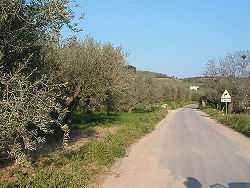
The location puts the area between the Canosa Murgia and Tavoliere delle Puglie, a few miles of Lake Locone. Due to the mild temperatures, typical of the area are the production of figs, prickly pears, almonds, lampascioni, peaches and cherries, without neglecting other vegetables (turnips, beets and Arugula), and vegetables. Recently (2005) there have been controversies and protests by farmers due to low scores on local products, which have followed the movement disruption and confrontation with the recording of incidents of crime. Farms surrounding cattle, sheep and goats guarantees the production of milk and cheese for the surroundings dairy industries.[36]
Handicrafts
The realization of handmade wicker baskets or clay pots are still frequent. Still practiced is the ancient crafts such as shoemaking.
Industry
Being a strategic road junction has allowed the city to host a fair number of distribution centers for goods, such as fruits and medicines. In recent decades, Canosa has developed several wineries and olive oil center, along with a major pasta factory. Since the early 2000s a planned incinerator in the territory Canosa, has led to many demonstrations and protests. After a long and complicated litigation between the City and the manufacturer of the plant in March 2007 a decision of the Council of State overturned the building permit for the construction of the plant.[37]
Tourism
The numerous archaeological sites related to Canosa attracts visitors and opening soon, will be the Provincial Archaeological Museum which will be built near the archaeological park of San Giovanni Baptistery.[38]
Transportation
Roads and highways
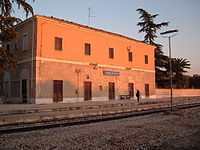
Canosa is located near one of the most important motorway hubs of southern Italy. From 1973, the Motorway A16 (Naples-Canosa, also known as Two Seas Highway) intersects Motorway A14 (Bologna – Taranto, also called the Adriatic highway). The toll of Canosa is 172 km from Naples, 611 km from Bologna and 133 km from Taranto. At average of 15 - 20 thousand cars, with peaks of 40 - 45 thousand units, and the toll road of Canosa will be extended.[39] In the northeast the modern Provincial Road 231 Andries Coratina (SS 98) parallels the Via Traiana built by Emperor Trajan in 108 AD, linking the ancient Trajan Benevento to Brindisi. In Roman times there was probably a port for shipment of goods, which still is an all-important reference port located at Barletta. Other roads of major importance are the Provincial Road 231 Andries Coratina (SS 98) and State Road 93 Appulo Lucana Barletta-Canosa.[40]
Railways
Canosa has a railway station, currently on the Barletta-Spinazzola line. The project dates back to 1861, but in 1888 is entered into an agreement with Southern Railways Company for the construction of the line. The railway line was inaugurated on August 1, 1895. Since the nineties the line was strongly curtailed.[41]
Twin Cities
Canosa is twinned with:
Sports
The soccer team of the city is the SS Canosa. The company's corporate colors are red and blue. Currently playing in the Promotion cup, but in the past has played in the Cup of Excellence and the Championship Series D. It also won the Amateur Cup of Italy. Among the sports facilities in the city include:
- Municipal Stadium Sabino Moroccan
- Stadio Comunale San Sabino
- Sports Palace
References
- ↑ Soprintendenza per i beni archeologici della Puglia, Marisa Corrente (a cura di) 1912 un ipogeo al confine: tomba Varrese: Canosa di Puglia, Palazzo Sinesi, 22 ottobre 2000, Canosa di Puglia, Serimed, 2001
- ↑ INEA - Istituto Nazionale di Economia Agraria
- ↑ Pagina con le classificazioni climatiche dei vari comuni italiani
- ↑ Jacobone, Nunzio (1922), Canusium. Un'antica e grande città dell'Apulia. Ricerche di storia e topografia, pp. 11-13. L'autore riporta le tre ipotesi (quella serviana, greca ed ebraica) respingendole ed ipotizza la derivazione messapica o iapigia.
- ↑ Jacobone, Nunzio (1922), Canusium. Un'antica e grande città dell'Apulia. Ricerche di storia e topografia, pp. 11-13. L'autore riporta le tre ipotesi (quella serviana, greca ed ebraica) respingendole ed ipotizza la derivazione messapica o iapigia.
- ↑ Francesco Grelle; Andrea Giardina, Canosa romana, Roma, "L'Erma" di Bretschneider, 1993.
- ↑ Attilio Paulicelli, San Sabino nella storia di Canosa, Bari, Tip. San Paolo, 1967.
- ↑ Attilio Paulicelli, San Sabino nella storia di Canosa, Bari, Tip. San Paolo, 1967.
- ↑ Attilio Paulicelli, San Sabino nella storia di Canosa, Bari, Tip. San Paolo, 1967.
- ↑ Questi ultimi poterono fregiarsi del titolo di "Principi di Canosa", attribuitogli ex Regio Decreto del 1914, partendo da Ernesto (1886), fino all'esplicito non riconoscimento dei titoli nobiliari sancito dalla Costituzione. Titolo, comunque, che è diventato parte integrante del nome.
- ↑ Ora sede della locale Fondazione Archeologica (F.A.C.) [2]
- ↑ Gerardo Chiancone, La Cattedrale e il Mausoleo di Boemondo in Canosa, Andria, Tip. Guglielmi, 1983
- ↑ Gerardo Chiancone, La Cattedrale e il Mausoleo di Boemondo in Canosa, Andria, Tip. Guglielmi, 1983
- ↑ Gerardo Chiancone, La Cattedrale e il Mausoleo di Boemondo in Canosa, Andria, Tip. Guglielmi, 1983
- ↑ Gerardo Chiancone, La Cattedrale e il Mausoleo di Boemondo in Canosa, Andria, Tip. Guglielmi, 1983
- ↑ Gerardo Chiancone, La Cattedrale e il Mausoleo di Boemondo in Canosa, Andria, Tip. Guglielmi, 1983
- ↑ Gerardo Chiancone, La Cattedrale e il Mausoleo di Boemondo in Canosa, Andria, Tip. Guglielmi, 1983
- ↑ Giuseppe Morea, L'acropoli-castello di Canosa, Bari, Arti grafiche Savarese, 1969
- ↑ Giuseppe Morea, L'acropoli-castello di Canosa, Bari, Arti grafiche Savarese, 1969
- ↑ Marisa Corrente; Claudio Ciccarone, Canusium: l'ipogeo dei serpenti piumati, Canosa di Puglia, Serimed, 2003.
- ↑ Marisa Corrente; Claudio Ciccarone, Canusium: l'ipogeo dei serpenti piumati, Canosa di Puglia, Serimed, 2003.
- ↑ Nunzio Iacobone, Una grande e antica città dell'Apulia. Canusium. Ricerche di storia e topografia, Galatina, Ed. Salentina, 1962.
- ↑ Nunzio Iacobone, Una grande e antica città dell'Apulia. Canusium. Ricerche di storia e topografia, Galatina, Ed. Salentina, 1962.
- ↑ Nunzio Iacobone, Una grande e antica città dell'Apulia. Canusium. Ricerche di storia e topografia, Galatina, Ed. Salentina, 1962.
- ↑ Nunzio Iacobone, Una grande e antica città dell'Apulia. Canusium. Ricerche di storia e topografia, Galatina, Ed. Salentina, 1962.
- ↑ Nunzio Iacobone, Una grande e antica città dell'Apulia. Canusium. Ricerche di storia e topografia, Galatina, Ed. Salentina, 1962.
- ↑ Stehl, Thomas (2004) "Dialetto canosino patrimonio culturale", Il Boemondo VII, 3, pp. 8-9. Il prof. Thomas Stehl è linguista e professore titolare del Dipartimento di Linguistica romanza presso l'Università di Potsdam.
- ↑ Soprintendenza per i beni archeologici della Puglia, Marisa Corrente (a cura di) 1912 un ipogeo al confine: tomba Varrese: Canosa di Puglia, Palazzo Sinesi, 22 ottobre 2000, Canosa di Puglia, Serimed, 2001.
- ↑ Soprintendenza per i beni archeologici della Puglia, Marisa Corrente (a cura di) 1912 un ipogeo al confine: tomba Varrese: Canosa di Puglia, Palazzo Sinesi, 22 ottobre 2000, Canosa di Puglia, Serimed, 2001.
- ↑ Soprintendenza per i beni archeologici della Puglia, Marisa Corrente (a cura di) 1912 un ipogeo al confine: tomba Varrese: Canosa di Puglia, Palazzo Sinesi, 22 ottobre 2000, Canosa di Puglia, Serimed, 2001.
- ↑ Soprintendenza per i beni archeologici della Puglia, Marisa Corrente (a cura di) 1912 un ipogeo al confine: tomba Varrese: Canosa di Puglia, Palazzo Sinesi, 22 ottobre 2000, Canosa di Puglia, Serimed, 2001.
- ↑ Soprintendenza per i beni archeologici della Puglia, Marisa Corrente (a cura di) 1912 un ipogeo al confine: tomba Varrese: Canosa di Puglia, Palazzo Sinesi, 22 ottobre 2000, Canosa di Puglia, Serimed, 2001.
- ↑ P. Saunders Wine Label Language pg 196 Firefly Books 2004 ISBN 1-55297-720-X
- ↑ La Compagnia Aurora, fondata da Lorenzo Dell'Aquila, cominciò nel 1882 ed è stata la prima in assoluto a proporre al pubblico pugliese le marionette con armature luccicanti, occhi di cristallo, impegnati in amori e duelli. Sono stata l'ultima compagnia del loro genere a calare il sipario nella seconda metà degli anni ottanta.
- ↑ La Compagnia Aurora, fondata da Lorenzo Dell'Aquila, cominciò nel 1882 ed è stata la prima in assoluto a proporre al pubblico pugliese le marionette con armature luccicanti, occhi di cristallo, impegnati in amori e duelli. Sono stata l'ultima compagnia del loro genere a calare il sipario nella seconda metà degli anni ottanta.
- ↑ Articolo de La Repubblica del 29 agosto 2005.
- ↑ Comune di Canosa di Puglia, Ufficio Stampa , Comunicato Stampa 22 marzo 2007.
- ↑ Comune di Canosa di Puglia, Ufficio Stampa , Comunicato Stampa 22 marzo 2007.
- ↑ Comune di Canosa di Puglia, Ufficio Stampa, Comunicato Stampa 7 dicembre 2006.
- ↑ Comune di Canosa di Puglia, Ufficio Stampa, Comunicato Stampa 7 dicembre 2006.
- ↑ Comune di Canosa di Puglia, Ufficio Stampa, Comunicato Stampa 7 dicembre 2006.
| Wikimedia Commons has media related to Canosa di Puglia. |

